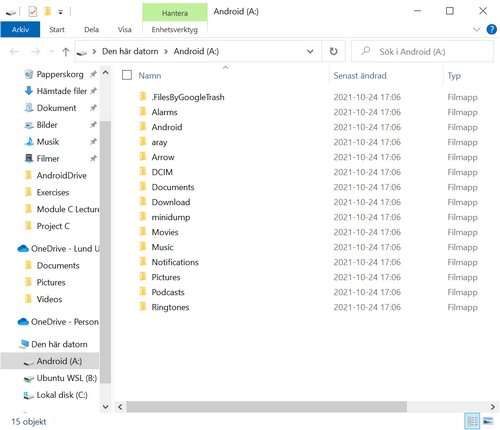AndroidDrive 2.1.0 | Dokan 2.0.6
AndroidDrive is a program that allows mounting Android smartphones/tablets as drives on Windows.
When AndroidDrive is running and you connect an Android device, AndroidDrive will automatically mount a drive containing that device's internal storage (files, folders).
Once you have started AndroidDrive, connected Android smartphones/tablets are recognized as a new drive in Windows Explorer. In this way, any files, photos or other media can be moved back and forth between the Windows computer and your Android device.

When AndroidDrive is running and you connect an Android device, AndroidDrive will automatically mount a drive containing that device's internal storage (files, folders).
Once you have started AndroidDrive, connected Android smartphones/tablets are recognized as a new drive in Windows Explorer. In this way, any files, photos or other media can be moved back and forth between the Windows computer and your Android device.
Setup
To be able to use AndroidDrive, you need to do three things (the order in which you do them doesn't matter):
- Install AndroidDrive on your Windows computer: Either use the installation program, or download and extract the zip file. If you want to start AndroidDrive when Windows starts, create a shortcut to AndroidDrive in %appdata%\Microsoft\Windows\Start Menu\Programs\Startup.
- Install Dokan on your Windows computer: The easiest way is to use their installation program (this is the installation program for Dokan 2.0.6, which is the version AndroidDrive was tested on). If you prefer, you can find other ways to install Dokan in their documentation.
- Enable USB debugging on your Android device: For AndroidDrive to be able to detect and interact with your Android device, you need to enable USB debugging. To do so, follow these steps:
- Open Settings on your Android device.
- Go to «About phone».
- Scroll down to the bottom and tap «Build Number» seven times until you get a message saying that you're a developer.
- Go back to the main settings screen, then go to System > Advanced > Developer Settings and enable USB debugging.
Usage
When AndroidDrive is running and you connect an Android device, AndroidDrive will automatically mount a drive containing that device's internal storage.
If you don't want AndroidDrive to mound a drive for a specific Android device, you can right click on the AndroidDrive icon in the task bar, go to Devices and click «Device settings», then uncheck «Automatically connect drive». To actually disconnect it, you also need to click «Disconnect drive» in the Devices window. You can also temporarily disconnect a drive by clicking «Disconnect drive» without changing the device settings.
When AndroidDrive detects a new Android device, it will automatically be assigned the first available drive letter after C (for example if your only drive is the hard drive, this will mean that it will be assigned the letter D). You can change the drive letter assigned to a specific Android device by right clicking on the AndroidDrive icon in the task bar, going to Devices, clicking «Device settings» and selecting a drive letter under «Drive letter». If you do this to a drive that's already connected, you will need to disconnect and re-connect the drive for the changes to take effect.
If you don't want AndroidDrive to mound a drive for a specific Android device, you can right click on the AndroidDrive icon in the task bar, go to Devices and click «Device settings», then uncheck «Automatically connect drive». To actually disconnect it, you also need to click «Disconnect drive» in the Devices window. You can also temporarily disconnect a drive by clicking «Disconnect drive» without changing the device settings.
When AndroidDrive detects a new Android device, it will automatically be assigned the first available drive letter after C (for example if your only drive is the hard drive, this will mean that it will be assigned the letter D). You can change the drive letter assigned to a specific Android device by right clicking on the AndroidDrive icon in the task bar, going to Devices, clicking «Device settings» and selecting a drive letter under «Drive letter». If you do this to a drive that's already connected, you will need to disconnect and re-connect the drive for the changes to take effect.
Screenshots

Homepage
OS: Windows 7 / 8 / 8.1 / 10 (x86-x64)
Language: ML / ENG
Medicine: FreeWare
Size: 19,32 / 17,74 MB.
Download From Homepage
Installer AndroidDrive | Portable AndroidDrive | Installer Dokan

No comments